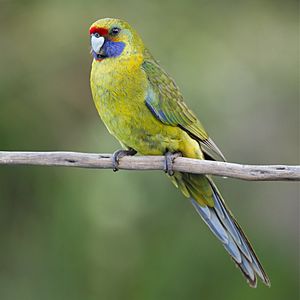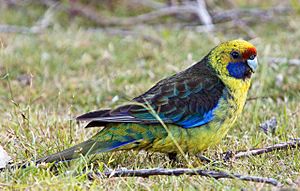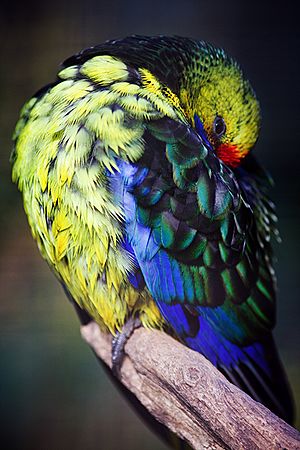Green rosella facts for kids
Quick facts for kids Green rosella |
|
|---|---|
 |
|
| Conservation status | |
| Scientific classification | |
| Genus: |
Platycercus
|
| Species: |
caledonicus
|
 |
|
| Range (in green) in Tasmania | |
| Synonyms | |
|
Psittacus caledonicus Gmelin, 1788 |
|
The green rosella or Tasmanian rosella (Platycercus caledonicus) is a type of parrot. It lives naturally in Tasmania and the Bass Strait islands. This bird was first described in 1788 by a German scientist named Johann Friedrich Gmelin. He mistakenly thought it came from New Caledonia, which is how it got part of its scientific name.
The green rosella is the biggest kind of rosella parrot. It can grow to about 37 centimeters (14.5 inches) long. Its body, neck, and head are mostly yellow. It has a red stripe above its beak and blue-purple cheeks. The back of the bird is a mix of black and green. Its long tail is blue and green. Male and female green rosellas look quite similar. However, females have duller yellow feathers and more red marks. Their beaks are also smaller. Young birds are mostly green.
You can find green rosellas in many places where there are trees. They mostly eat plants, like seeds, berries, nuts, and fruits. They also enjoy flowers. Sometimes, they eat insect larvae and small insects. Green rosellas build their nests in tree hollows. This bird is common in Tasmania. It is listed as "least concern" by the International Union for Conservation of Nature (IUCN). This means it is not currently at high risk of disappearing. However, a special group of green rosellas on King Island is considered vulnerable. This is because much of their home on the island has been cleared away.
Contents
About the Green Rosella's Name
A green rosella was first collected in Adventure Bay, Tasmania, in 1777. This happened during Captain James Cook's third voyage. The ship's doctor, William Anderson, collected many birds. However, he died before returning home. Many notes and locations were mixed up later.
The bird specimen ended up with a British scientist, Sir Joseph Banks. Another English scientist, John Latham, saw it there. He wrote about the green rosella in the 1780s. He called it the "Caledonian parrot." This was because he wrongly thought it came from New Caledonia.
Later, in 1788, the German scientist Johann Friedrich Gmelin officially described the species. He gave it the scientific name Psittacus caledonicus. In 1825, another scientist, Nicholas Aylward Vigors, created the group (genus) called Platycercus. This is the group that rosellas belong to.
Today, "Green Rosella" is the official name. Other common names include Tasmanian rosella and yellow-breasted parakeet. Early settlers in Tasmania sometimes called it the "hill parrot." The green rosella is one of six types of rosellas. It is closely related to the crimson rosella.
What the Green Rosella Looks Like
The green rosella is the largest bird in the rosella family. It measures about 29 to 36 centimeters (11 to 14 inches) long. Its wings are long and narrow, with a wingspan of 44 to 54 centimeters (17 to 21 inches). It also has a long tail with twelve feathers.
Adult male green rosellas are heavier than females. Males weigh about 150 grams (5.3 ounces), while females weigh around 120 grams (4.2 ounces). Males also have a larger beak.
An adult green rosella has a yellow head and belly. Its cheeks are blue, and it has a red band above its beak. The yellow feathers on its head and body can have red marks. The back of the bird is black or dark brown with green edges on the feathers. Its long tail is dark green with dark blue outer feathers. The wings are mostly black and green with blue-purple parts. The bird's eyes are brown, and its beak is pale grey. Its legs are grey.
Female green rosellas have duller yellow feathers. They also have more noticeable red marks than males. The green edges on their black back feathers are also clearer.
Young green rosellas look different. When they first leave the nest, they are mostly dark green. Their wings and tail are shorter than adult birds. They also have a stripe under their wings that adults do not have. As they get older, they start to get patches of yellow feathers like adults. They usually shed their feathers (moult) between January and April each year.
Where Green Rosellas Live and Their Homes
The green rosella is a very common bird in Tasmania and the Bass Strait islands. You can also find it on smaller islands nearby, like Maria and Bruny Islands. These birds usually stay in one area and do not migrate far. Even birds living in high mountains do not move to warmer places.
On King Island, the green rosella has become rare. This is because much of their natural home has been cleared. Also, they might compete with the common starling for nesting spots. On King Island, they mostly stay in the Pegarah forest during breeding season.
Green rosellas live in many different places as long as there are some trees. They can be found up to 1500 meters (5000 feet) above sea level. Their homes include rainforests, forests with tough-leaved trees, woodlands, and coastal areas. They also live in fields, orchards, and even city parks and gardens.
Green Rosella Behaviour
Green rosellas are usually seen in pairs or small groups. Young birds might gather in larger groups of 20 or more when it's not breeding season. Sometimes, they can be seen with eastern rosellas. They fly in a straight line, flapping their wings quickly and then gliding for a short time.
The green rosella makes a repeated two-syllable call while flying. It sounds like "kussik kussik" or "cossack cossack." When they are sitting, they make a rising "kwik-kweek kwik-kweek" sound. During courtship, they make a chattering call. If they are scared, they can make a loud, sharp screech.
Reproduction and Life Cycle
Green rosellas usually start breeding when they are two years old. The breeding season is from September to January. They usually have one group of chicks per year.
They build their nests in hollows inside tree trunks. These hollows are usually over 1 meter (3 feet) deep. The nest can be as high as 30 meters (100 feet) off the ground. They often choose eucalyptus trees like Tasmanian bluegum or mountain ash. Sometimes, they even nest in chimneys or holes in walls.
The female lays four or five white, slightly shiny eggs in September or October. Each egg is about 30 x 24 millimeters. The female sits on the eggs alone for about 19 to 23 days. When the chicks hatch, they are covered in soft white down feathers. They are very helpless at first. The chicks leave the nest about four to five weeks after hatching. They then join other young birds in flocks. However, their parents still feed them for about two more weeks after they leave the nest.
Feeding Habits
Green rosellas mostly eat plants. They eat a lot of seeds from grasses and trees, especially eucalyptus trees. They also eat seeds from soft tree ferns, cranberry heath, and myrtle beech. Other foods include berries, nuts, and fruits. They also enjoy flowers and new buds from various trees and shrubs.
Sometimes, they eat berries from common hawthorn or other plants. They might also eat insect larvae and small insects called psyllids. They find these insects inside bumps (galls) on eucalyptus leaves.
Green rosellas usually look for food in the tops of trees or in bushes. In open areas, they search in hedges, shrubs, and trees. They also come down to the ground to eat fallen fruit or spilled grain in farms and orchards. They are quiet when on the ground but noisy when in trees.
They usually feed in pairs or small groups of fewer than 20 birds. However, larger groups of 50 to 70 birds have been seen eating blackberries or thistles in fields. When they eat, they often hold the food with their left foot. They use their beaks to get the edible parts or to break open nut shells.
Status and Conservation Efforts
In 2016, the green rosella was listed as "least concern" on the IUCN Red List of Endangered species. This means it is not currently at high risk. This is because it lives across a large area, more than 20,000 square kilometers (7700 square miles). Also, its population is not declining quickly.
However, the special group of green rosellas on King Island is listed as "vulnerable." This means they are at risk. Their population is thought to be fewer than 500 birds. About 70% of King Island's natural plant life has been cleared. The remaining areas are broken up and at risk from frequent bushfires.
Like most parrots, the green rosella is protected by an agreement called CITES. It is on the Appendix II list of vulnerable species. This means it is illegal to import, export, or trade wild-caught green rosellas.
Keeping Green Rosellas as Pets
Green rosellas were often caught and kept as pets until the early 1900s. People say they are tougher and easier to care for in captivity than other rosellas. However, they are not very popular as pet birds. This might be because their colors are not as bright as some other parrots.
As mentioned, the green rosella is protected by CITES. This means it is illegal to trade wild-caught birds.
These birds can sometimes become lazy and gain too much weight in captivity. So, it is suggested to keep them in a large aviary (a big bird cage) that is at least 5 meters (15 feet) long. This helps them stay active. It is also recommended to feed them very few or no sunflower seeds. Green rosellas breed late in the season. Their chicks can be small during the summer heat, which can cause problems for them.
See also
 In Spanish: Perico de Tasmania para niños
In Spanish: Perico de Tasmania para niños





